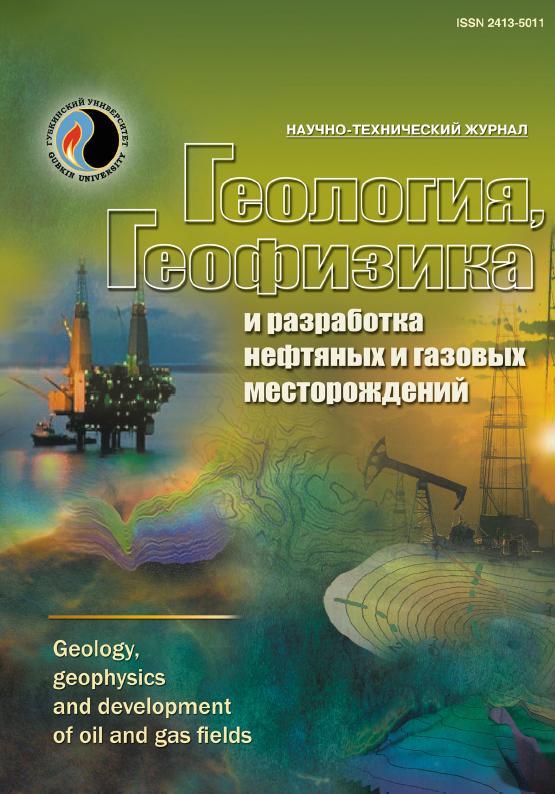Scientific and technical journal
«Geology, geophysics and development of oil and gas fields»
ISSN 2413-5011

Types of diagenetic changes in carbonate sediments of the Ilam formation within the boundaries of Bangestan structural zone (Iran)
UDC: 553.98(55)
DOI: -
Authors:
1 National University of Oil and Gas "Gubkin University", Moscow, Russia
Keywords: Zagros basin, Bangestan, Ilam formation, diagenesis, carbonate formations, natural reservoirs, fields
Annotation:
The data of an exploratory well located in one of the fields of the Persian Gulf were used for researching diagenetic processes of Ilam formation. The Ilam formation of Santonian-Campanian age is one of the main reservoirs of the Bangestan group in the Zagros oil-bearing basin and is composed mainly of carbonate rocks. Diagenetic changes of the rocks, that compose the Ilam formation, were studied in two sections: Tang-e-Ban and Tang-e-Abolfares, located in the southwestern Iran. The main diagenetic processes manifested in the deposits of the Ilam formation are leaching, cementation, compaction, micritization, bioturbation, ferrugination, silicification, dolomitization as well as presence of glauconite. The following types of void space were identified: intra-form, inter-form, fracture, channel leaching zones and caverns. The most important types of cement in this formation are poikilite cement, pore-filling and shaped-element cement as well as crustifying cement. The processes of Ilam formation diagenesis proceeded under various conditions, including marine, meteoric and buried environments. There are three stages of rock transformation: early diagenesis, late diagenesis and hypergenesis.
Bibliography:
1. James G.A., Wynd J.G. Stratigraphic nomenclature of Iranian oil consortium agreement area // AAPG Bulletin. – 1965. – Vol. 49. – Pp. 2182–2245. – DOI: 10.1306/A663388A-16C0-11D7-8645000102C1865D
2. Afghah M., Farhoudi G. Boundary between Upper Cretaceous and Lower Paleocene in the Zagros Mountain Ranges of southwestern Iran // Acta Geologica Sinica. – 2012. – № 86. – Pp. 325–338.
3. Stocklin J. Structural history and tectonics of Iran: a review // AAPG Bulletin. – 1968. – Vol. 52. – № 7. – Pp. 1229–1258.
4. Sepehr M., Cosgrove J.W. Role of the Kazerun Fault Zone in the formation and deformation of the Zagros Fold-Thrust Belt, Iran. // Tectonics. – 2005. – Vol. 24(5). – DOI: 10.1029/2004TC001725
5. The structure and kinematics of the southeastern Zagros fold-thrust belt, Iran: From thin-skinned to thick-skinned tectonics / M. Molinaro, P. Leturmy, J.C. Guezou [et al.] // Tectonics. – 2005. – Vol. 24(3). – DOI: 10.1029/2004TC001633
6. Choquette P.W., Pray L.C. Geologic nomenclature and classification of porosity in sedimentary carbonates // AAPG Bulletin. – 1970. – Vol. 54. – Pp. 207–250.
7. Lucia F.J. Petrophysical parameters estimated from visual description of carbonate rocks: A field classification of carbonate pore space // Journal of Petroleum Technology. – 1983. – Vol. 35. – Pp. 626–637. – DOI: 10.2118/10073-PA
8. Scholle P.A., Ulmer-Scholle D.S. A Color Guide to the Petrography of Carbonate Rocks: Grains, Textures, Porosity, Diagenesis // AAPG Memoir. – 2003. – Vol. 77. – 495 p.
9. Dmitriev S.A., Khayrullin I.I., Isaev A.B. Diageneticheskie effekty v nizkoporovykh izvestnyakakh fatsiy otmeley, lagun i ikh perekhodnykh raznostyakh formatsii Mishrif mestorozhdeniya Zapadnaya Kurna-2 // Geologiya, geofizika i razrabotka neftyanykh i gazovykh mestorozhdeniy. – 2022. – № 12(372). – S. 13–23. – DOI: 10.33285/2413-5011-2022-12(372)-13-23
10. Schneider J., Bechstädt T., Machel H.G. Covariance of C- and O-isotopes with magnetic susceptibility as a result of burial diagenesis of sandstones and carbonates: an example from the Lower Devonian La Vid Group, Cantabrian Zone, NW Spain // International Journal of Earth Sciences. – 2004. – Vol. 93. – Pp. 990–1007. – DOI: 10.1007/s00531-004-0434-3
11. Palaeo-exposure surfaces in Cenomanian-Santonian carbonate reservoirs in the Dezful embayment, SW Iran / H. Rahimpour-Bonab, H. Mehrabi, A. Navidtalab [et al.] // Journal of Petroleum Geology. – 2013. – № 36(4). – Pp. 335–362. – DOI: 10.1111/jpg.12560
12. James N.P., Choquette P.W. Diagenesis 9. Limestones – The meteoric diagenetic environment // Geoscience Canada. – 1984. – № 11. – Pp. 161–194.
13. Heydari E. Hydrotectonic models of burial diagenesis in platform carbonates based on formation water geochemistry in North American sedimentary basins. – 1997. – DOI: 10.2110/ pec.97.57.0053
14. Nelson R.A. An experimental study of fracture permeability in porous rock // American Rock Mechanics Association (ARMA). – 1976. – Pp. 76–0127. – DOI: 10.1306/C1EA3C2B-16C9-11D7-8645000102C1865D
15. Block size and fracture permeability in naturally fractured reservoirs / S. Rivas-Gomez, J. Cruz-Hernandez, J. Gonzalez-Guevara, A. Pineda-Munoz // Abu Dhabi International Petroleum Exhibition and Conference, 13–16 October 2002. – 2002. – DOI: 10.2118/78502-MS
16. Tucker M.E. Sedimentary Petrology. – Oxford: Blackwell, 2001. – 262 p.
17. Rao C.P. Geochemical differences between subtropical (Ordovician), cool temperate (Recent and Pleistocene) and subpolar (Permian) carbonates, tasmania, Australia // Carbonates and Evaporites. – 1991. – Vol. 6. – Pp. 83–106. – DOI: 10.1007/BF03175385
18. Depositional history of the Lower Eocene drowned carbonate platform (Drunka Formation), west of Assiut-Minia stretch, Western desert, Egypt / M.A. Khalifa, M.A. El Ghar, S.A. Helal, A.W. Hussein // 7th International Conference on the Geology of the Arab World. – 2004. – Pp. 233–254. – DOI: 10.1016/j.jafrearsci.2017.02.0
19. Flugel E. Microfacies of Carbonate Rocks, Analysis, Interpretation and Application. – Berlin: Springer-Verlag, 2010. – 976 p.
20. Tucker M.E., Wright V.P. Diagenetic processes, products and environments // Carbonate sedimentology. – 1990. – Pp. 314–364. – DOI: 10.1016/j.jafrearsci.2017.02.017